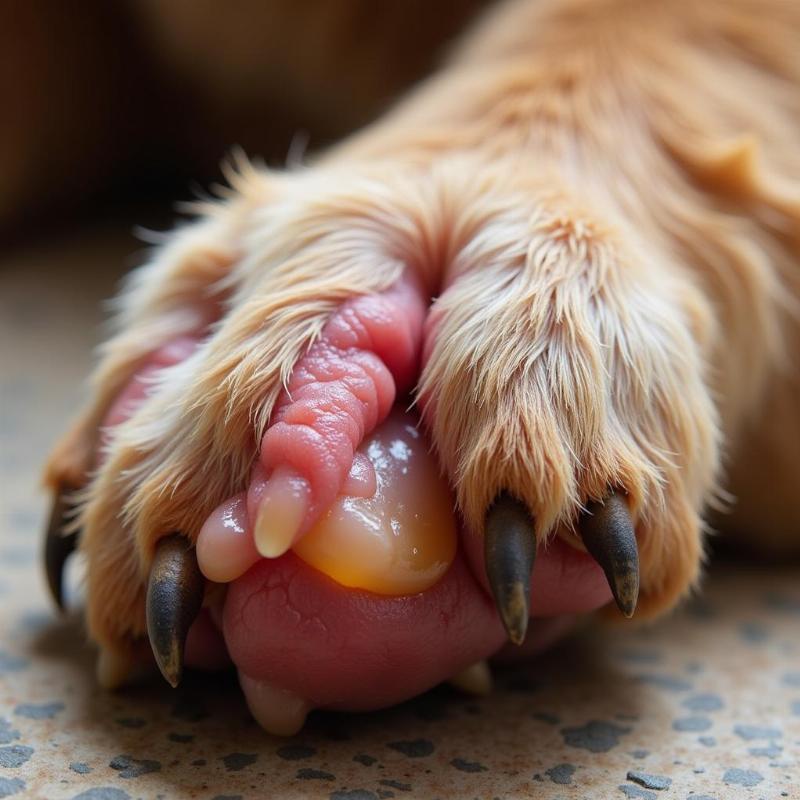Dog nail bed infections can be painful and concerning for both you and your furry friend. If you’re searching for “nail bed infection dog nails pictures” you’re likely worried about your dog’s paw health. This article will guide you through identifying, treating, and preventing nail bed infections in dogs, providing valuable insights illustrated with helpful images.
A dog’s nails are essential for traction, digging, and even defense. A healthy nail is smooth and hard, but an infection can cause significant discomfort and even lead to more serious complications if left untreated. Recognizing the signs early is crucial. This comprehensive guide will equip you with the knowledge you need to ensure your dog’s paws stay healthy and happy.
Recognizing a Dog Nail Bed Infection
Several signs can indicate a nail bed infection, ranging from subtle changes to more obvious symptoms. Look for redness, swelling, or discharge around the nail. Your dog might also lick or bite at their paw excessively. Pain or lameness are also common indicators. In severe cases, the nail may become brittle, discolored, or even detach from the nail bed.
 Dog Nail Bed Infection Image 1
Dog Nail Bed Infection Image 1
If your dog exhibits any of these symptoms, it’s crucial to seek veterinary attention. While some mild infections may respond to home remedies, a veterinarian can accurately diagnose the problem and prescribe the appropriate treatment. Delaying treatment can lead to more severe infections and complications.
Causes of Nail Bed Infections in Dogs
Nail bed infections can be caused by various factors, including bacteria, fungi, or yeast. Injuries to the nail, such as breaks or tears, can create an entry point for these microorganisms. Allergies, foreign bodies lodged in the paw, and underlying medical conditions can also contribute to infections.
Regularly checking your dog’s paws for any abnormalities can help prevent infections. Keeping your dog’s nails trimmed can minimize the risk of breaks and tears.
Treating Dog Nail Bed Infections
Treatment for nail bed infections varies depending on the severity and underlying cause. Your veterinarian may prescribe antibiotics, antifungals, or pain medication. Topical ointments or soaks may also be recommended. In some cases, surgical removal of the infected nail may be necessary.
“Early diagnosis and treatment are key to resolving nail bed infections quickly and effectively,” says Dr. Emily Carter, DVM, a renowned veterinary dermatologist in New York. “Ignoring the signs can lead to more complex and painful conditions.”
Preventing Dog Nail Bed Infections
Regular paw hygiene is crucial for preventing nail bed infections. Keep your dog’s nails trimmed and check their paws regularly for any cuts, breaks, or foreign objects. Avoid walking your dog in areas with sharp debris or harsh chemicals. If your dog is prone to allergies, work with your veterinarian to manage their condition and minimize the risk of secondary infections.
Dr. Sarah Miller, DVM, a leading veterinary surgeon in Los Angeles adds, “Regular grooming and paw checks can significantly reduce the risk of infections. It’s a simple yet effective preventative measure.”
Conclusion
Nail bed infections in dogs can be a painful but treatable condition. By understanding the causes, symptoms, and treatment options, you can help keep your furry friend’s paws healthy and happy. Regularly checking your dog’s paws and seeking prompt veterinary care at the first sign of infection are essential for preventing complications and ensuring a swift recovery. Remember, early detection and treatment are vital!
FAQ
- How can I tell if my dog has a nail bed infection? Look for redness, swelling, discharge, excessive licking, lameness, or changes in nail color or texture.
- What causes nail bed infections in dogs? Bacteria, fungi, yeast, injuries, allergies, foreign bodies, or underlying medical conditions.
- How are nail bed infections treated? Antibiotics, antifungals, pain medication, topical ointments, soaks, or surgical removal of the infected nail.
- How can I prevent nail bed infections in dogs? Regular paw hygiene, nail trimming, avoiding hazardous areas, and managing allergies.
- When should I take my dog to the vet for a suspected nail bed infection? As soon as you notice any symptoms.
- Can I treat my dog’s nail bed infection at home? No, always consult a veterinarian for diagnosis and treatment.
- Are certain dog breeds more prone to nail bed infections? Breeds with long nails or allergies might be more susceptible.
what to do if my dogs paw is swollen
dog nails hollow underneath pictures
Beautdogs.us is your premier destination for comprehensive dog care information, breed-specific guidance, and access to top-quality products. Whether you’re a new dog owner or a seasoned enthusiast, Beautdogs.us provides expert advice and resources to help you navigate the joys and challenges of dog ownership. We offer expert advice on everything from health and nutrition to training and grooming. Contact us today to learn more! Email: [email protected], Phone: +1 501-555-7529.